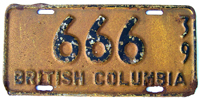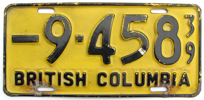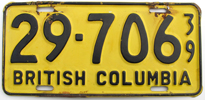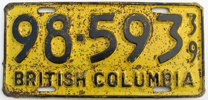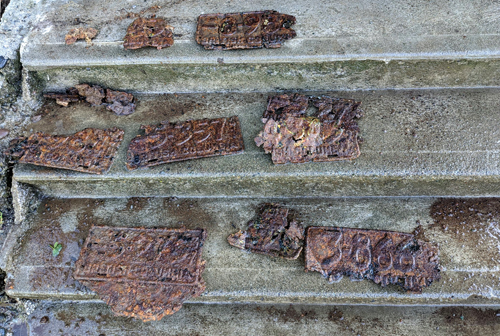|
British
Columbia Passenger License Plates
|
||||||||||||||||||||||||||||||||||||||||||||||||||||||||||||||||||||||||||||||||||||||||||||||||||||||||||||||||||||||||||||||||||||||||||||||||||||||||||||||||||||||||||||||||||||||||||||||||||||||||||||||||
Quick Links: |
The period between 1931 and 1976 is considered to be the "Prison Era" when BC plates were manufactured by inmates at Oakalla Prison in Burnaby. |
* * * * * |
Apparently, these new stream line cars were being provided with mounting brackets that were "so small that the ... license plates extend over the end and often get broken." In reality, this was more likely a cost cutting measure as the province also introduce a new letter prefix ("C") to be used on license plates issued to Commercial Trucks.
The colour of the plates was described as "patrol cream" on a green background while the date stamp at the left of the plate was modified by stacking the numbers in order to make more space available for the registration number. |
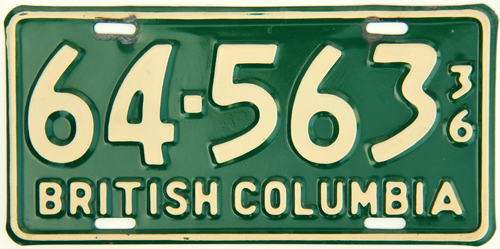
Great thought and care was devoted to this subject, as evidenced by one of the many "inventions" patented during this period, such as the "License Plate Color Combination Indicator" (shown at right) that were designed to ensure no two neighbouring jurisdictions ever used the same color in the same year. While such contraptions never caught on, states and provinces were generally aware of what those around them were up to for plate colours, which explains why green had last been seen as the background colour on BC license plates in 1923. Starting in 1926, Washington State had adopted an alternating green-and-white colour combination for its license plates (with the exception of 1928 when it used the same colours BC had applied to its plates in 1927): |
 |
 |
 |
 |
 |
 |
 |
 |
 |
 |
 |
As can be seen in the gallery of license plate above, the opportunity that allowed BC to re-introduce green was the decision by Washington State (truly the Evergreen State) to use the same blue and white colour schemes that BC had used in 1934 and 1935. |
| The 1936 No. 1 license plate |
At that time, the Merchant's Trust and Trading Company were building the Qualicum Beach Hotel (shown below right) and an adjacent golf course. Money also became a shareholder in the Company and, after the completion of the Great War in 1919, would return to Qualicum Beach to manage the new hotel and golf course. Money, apparently, was at ease among the wealthy and famous and was able to attract numerous Hollywood celebrities, well-known politicians and royalty to the hotel - putting Qualicum Beach on the map as an exclusive, up-scale resort destination. It is assumed that his out-going personality and the connections he was able to cultivate at the hotel, particularly with provincial politicians, allowed Money to procure for himself the No. 1 license plate possibly the late 1920s (NOTE: the Qualicum Beach topper shown in the photo below-left is an ad-on and is not associated with Money). |
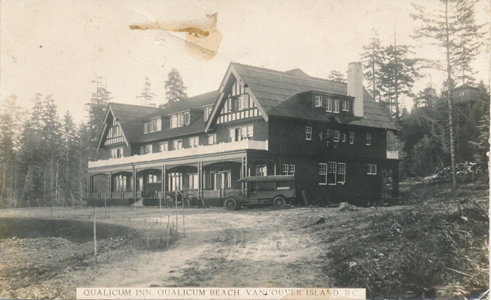 |
Money would hold the No. 1 until 1938 when it was repatriated by the provincial government for use on an official vehicle and he ultimately died three years later in 1941. The fate of the No. 1's that Money was issued is unknown, however, the 1936 shown above is purported to have been in a box of plates purchased at a garage sale in Qualicum Beach many years ago. As often happens in these cases, details of the location of the garage sale have become blurry as time passes. All that is known is that the couple that purchased the box had to travel up a very long driveway to the house where the sale was happening. While this is not much to go on, Qualicum Beach is also not a very big municipality and it is thought that the house in question might have been at what is now known as the "Milner Gardens and Woodland". Money had constructed a house on the estate that would become the Gardens and Woodland for his mother and sister in 1929 before eventually selling to Ray & Rina Milner in 1937. |
|
It is not un-heard of for old license plates to be unearthed in garages decades after being issued and it would seem that Money may have left at least one of his 1936 No. 1 plates in the garage when the property was sold to the Milner's. |
 |
The jump was attributable to improving economic conditions and the sale of new cars. As a result, registrations were up 20% and "licensing offices [were] running short of new plates." By the end of the licensing year on February 28, 1937, approximately 104,444 vehicles had been registered. Of these, 84,062 were Passenger vehicles, which did not exceed the 90,000 sets of license plates that Oakalla had made for 1936. |
* * * * * |
The Vancouver Sun announced the 1937 colour scheme to be "a wonderful combination for funerals" and then proceed to lambaste the province's track record in picking license plate colours, declaring: |
... the general crumminess - if we may say so - of our British Columbia license plates, year after year, has been the subject of considerable comment among visitors from other provinces and states ... [and] while the cars from other sections of the country come in here bearing plates of graceful shape, artistic lettering and bright pleasing colors, our plates are ugly, clumsy and drab. Even the colors are muddy ... Cannot we get bright, pleasing colors? Our present and past plates look so cheap it is pitiful. |
Surely, it was opined, "the cost involved would rapidly be dwarfed by the gain to British Columbia business flowing from an increased tourist traffic"? |
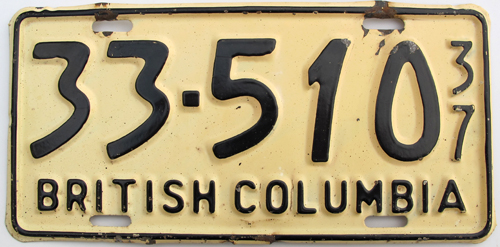
| 1937 | |||||||||||||||||||||||
1-digit |
|
||||||||||||||||||||||
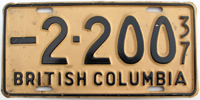 |
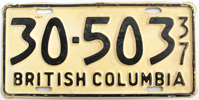 |
||||||||||||||||||||||
| The Great Border Brouhaha of 1936-37 |
If I hadn't a winter home here, I would have gone south to California as many other prairie families with means have done this winter. The reason is that the B.C. government has placed police on the highway entering British Columbia from Alberta to stop west-bound tourists. The idea apparently is to keep out prospective relief cases. But in doing this the police are also turning away the families with money. The police stop all cars from the prairies and force the drivers to buy B.C. motor license plates ... That attempts to force motor tourists to buy B.C. licenses for cars already licensed is quite illegal was admitted to be so by the police when I stood on my rights and refused to pay over the money. I have been coming here for ten years and eight years ago bought three-quarters of an acre and a house at Cadboro Bay for my winter home. When the police saw I knew my rights they backed down and let me through. Soby's experience brought to the fore an aspect of provincial legislation that had been in effect since cars first began to be registered (and remains in force to this day) which is that people moving to the province must obtain BC a driver's license and plates.
The length of time that a tourist could stay in the province was determined by the reciprocal agreement their home province had with BC. So, for motorists from Ontario and Saskatchewan, the permitted stay was 3-months while Alberta and Manitoba motorists could stay 6-months. The crack-down had actually begun the previous summer, when prairie tourists began to complain in June of 1936 of the obnoxious attitude of young BC Provincial Police officers assigned to question motorists at the border and requiring them to affix a "bright yellow placard" to their windshield if they wanted to enter the province. According to the Provincial Police, during the first ten months of 1936, approximately 5,768 "tourist permits" had been issued to motorists crossing at either the Crow's Nest Pass (4,588) or at Radium (1,180). During the same period, over 1,000 motorists from the prairie provinces had been forced to surrender their plates and pay for a new set of BC license plates as they were determined by the police to be relocating permanently to the province. That these actions by the police also resulted in the collection of over $26,000 (over $500,000 in 2023 dollars) can't be ignored. September of 1936 is when the screws appear to have really been tightened at the border, with Soby's ordeal happening the following month.
When other motorists came forward with similar stories to Soby, including that of a Mr Neave of Milner (now part of Langley), and their plight championed by the Winnipeg Free Press newspaper who excoriated the province for its tactics, did the real "Brouhaha" begin: |
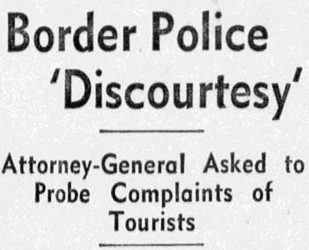 |
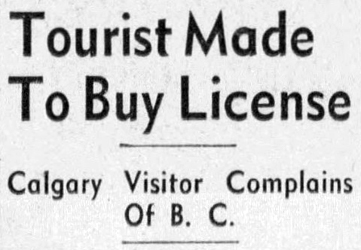 |
The Free Press took up the case of A.F. Menzies, who was "known" to the paper, recounting how the BC Provincial Police had also "stopped him, put him through an inquisition, treated him to a good display of bureaucratic tyranny, and finally allowed him to enter the province only after he had 'requested' to be allowed to buy B.C. license plates for his car." To the Free Press, "the episode is outrageous. What kind of a country have we got when provincial police can patrol provincial borders and stop honest Canadian citizens from passing from one province to another? Is this Canada or Balkan Europe? ... Heaping insult upon insult, the [Police] Commissioner [states] ... that British Columbia does everything possible to assist 'bona fide tourists' ... What is a bona fide tourist? And how do the B.C. border patrols detect them? One condition is, apparently, that they must 'request' B.C. license plates. Mr. Menzies says he - and others - could not get past the patrol without buying them. We believe Mr. Menzies." BC Attorney General, Gordon Sloan, attempted a response by delcaring the police "merely checked on all incoming motorists to see that they were not likely to become public charges in British Columbia. In all cases where it is clear that the visitors are genuine tourists they are not hampered in any way" and he further denied they were required to buy BC license plates. |
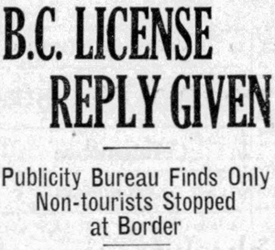 |
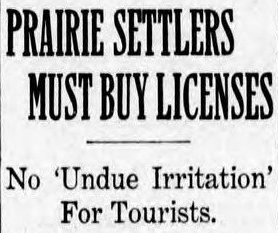 |
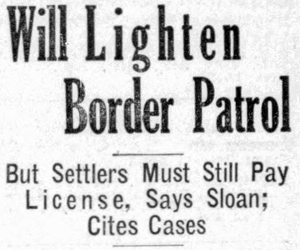 |
Attorney General Sloan subsequently announced that steps would be taken to reduce the irritation at the Crow's Nest border crossing but that priarie folks relocating to BC would still need to acquire the necessary driver's license and plates. The solution was to be the replacement of patrols at the border with signs (like the one shown at right for Pouce Coupe) asking motorists to report to the closest Provincial Police office. |
Sometimes life in the big city of Vancouver in the 1930s just comes across as being much simpler. Take this story, for example: |
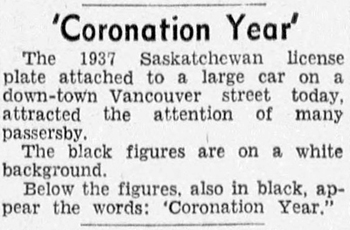 |
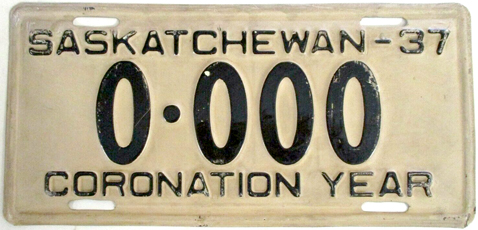 |
While it is possible that the "passersby" were impressed that someone from the Prairies had made it through the Provincial Police dragnet occurring at the Alberta border with their license plates intact, we suspect that the true novelty of the plates was the slogan, marking the official Coronation of George VI as British Monarch on May 12, 1937. The similarity in colour to BC's own plates must have caused some initial confusion. The Coronation had been planned for over a year and was initially intended for George's brother, Edward VIII, before he abdicated in December of 1936. Fortunately for Saskatchewan, which had likely already manufactured its plates for 1937 when the abdication happened, George stepped in and kept the May 12th date. |
* * * * * |
It was stated that 35,000 of an estimated 100,000 license plates had been made at Oakalla by July of 1937 with the remainder of the order being complete by the end of the year. Additional plates would be made as and when required. |
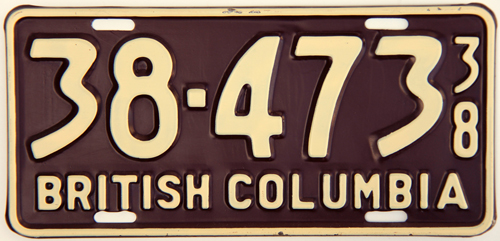
| 1938 | |||||||||||||||||||||||
1-digit |
|
||||||||||||||||||||||
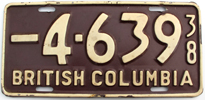 |
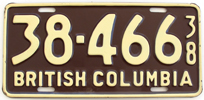 |
||||||||||||||||||||||
The distinctive "slanting" dies created by J.R. Tacey & Son for use on the 1924 license plates, and purportedly inspired by Massachusetts license plates, would have been used to make over 675,000 sets of Passenger plates (1,350,000 individual plates) by 1937. To ensure that the lettering and numbering on the plates continued to stand out, be crisp, sharp and clear new dies were ordered for 1938. These dies were described as being the same as the dies used to make the 1937 license plates and an analysis of the stamped letters and numbers between the two years bears this out: |
1937 British Columbia Die Types (0-9) |
|||||||||
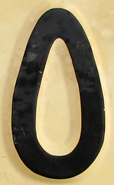 |
 |
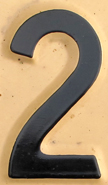 |
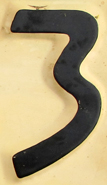 |
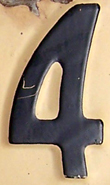 |
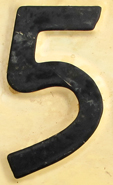 |
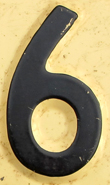 |
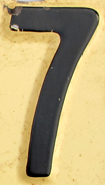 |
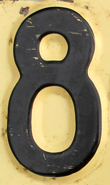 |
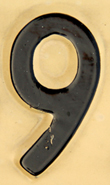 |
1938 British Columbia Die Types (0-9) |
|||||||||
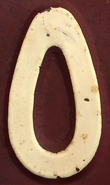 |
 |
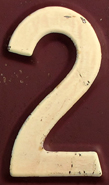 |
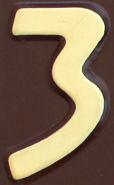 |
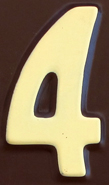 |
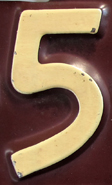 |
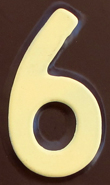 |
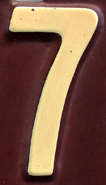 |
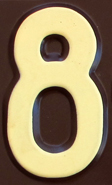 |
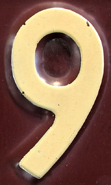 |
To the un-initiated, it is difficult to tell the difference between the stamped numerals on the 1937 versus 1938 plates, so we'll just have to take the Provincial Police's word for the improved legibility from using new dies in 1938. We do tip our hats to whoever designed and machined the dies to resemble as closely as possible the previous set of dies as they look indistinguishable. |
The hope was to be able to counter California's own advertising of the Fair on its license plates, theoretically drawing tourists away from British Columbia, including local motorists. Success, however, was going to be dependent on arrangements being made for new dies to stamp the slogan / emblem (or both) on the plates and "a satisfactory slogan" being found. |
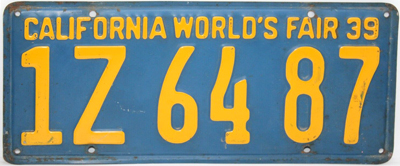 |
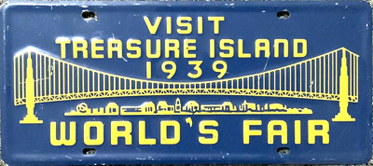 |
While the slogan on BC plates never implemented, likely due to the small size of the new "streamlined" plates introduced in 1936, Premier Duff Pattullo did confirm local business fears by travelling to attend the World's Fair the following year rather than stay-cation in BC. Granted, Pattullo, his wife, secretary and government chauffeur were on official business, having been invited to attend the Fair for Dominion Day Celebrations on July 1, 1939. This allowed Pattullo to take the provincial limousine, which displayed the No. 1 license plate (which had been repatriated from Noel Money the year before, to San Francisco for the event. |
* * * * * |
In other reports, the plates were described as black on a "lemon yellow" background. As in previous years, and because of the limitation of the "slimline" plates introduced in 1936 to accommodate only 5 characters, the number of license plates ordered from Oakalla was 99,999, which just accommodated the 96,373 registrations for the year. For whatever reason, 1939 is a tough paint year with the yellow on many plates having deteoriated with the result that the plates are afflicted with rust, discolouration and fading. By the standards of the previous decade, however, 1939 was an otherwise un-eventful year for license plates with little news to report on. |
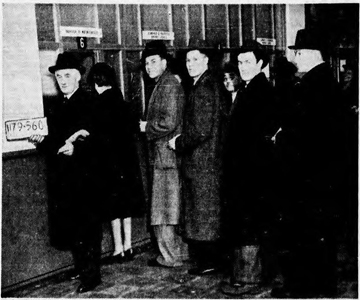 |
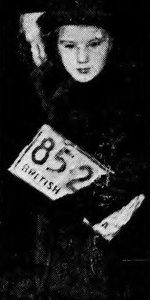 |
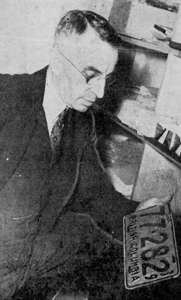 |
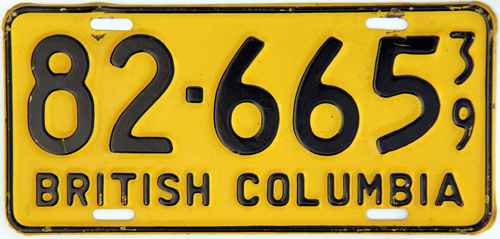
| 1939 | |||||||||||||||||||||||
 |
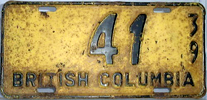 |
|
|||||||||||||||||||||
 |
|||||||||||||||||||||||
 |
|||||||||||||||||||||||
Following the decision not to put a slogan on the 1939 license plates, the Vancouver Tourist Association declared "our license plates are hardly a thing of beauty. Their color should be enlivened. Also, every plate next year should carry the slogan, "See British Columbia - Canada's Evergreen Playground" (also reported as "Canada's Eevrgreen Empire") along with a small evergreen tree logo. The Vancouver Sun commented that "tourists in the main do not travel to see evergreens, bu they DO travel to see people. Why not, then, emulate Victoria's excellent example and amphasize 'A bit of Old England'?" |
Quick Links: |
|
© Copyright Christopher John Garrish. All rights reserved.

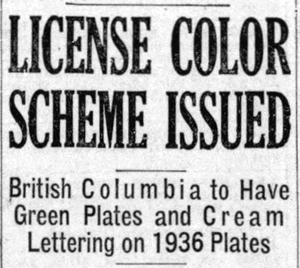 Described as a design change to "accommodate the new stream line cars" being made by North American auto makers, the province announced that 1936 license plates would be two inches shorter (being reduced from 13.5 to 11.5 inches in length) than those issued in previous years.
Described as a design change to "accommodate the new stream line cars" being made by North American auto makers, the province announced that 1936 license plates would be two inches shorter (being reduced from 13.5 to 11.5 inches in length) than those issued in previous years.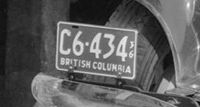
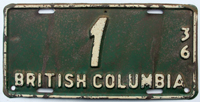
.jpg)
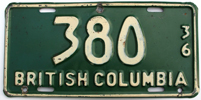
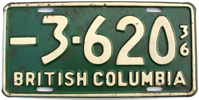
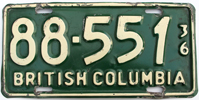

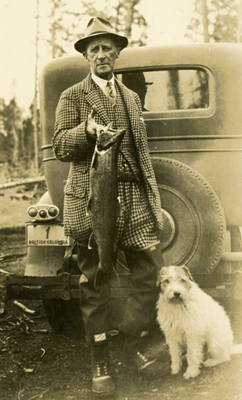
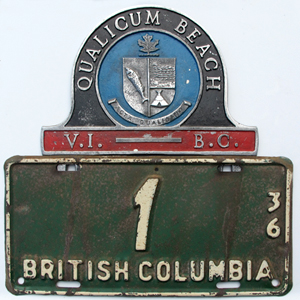

 By October of 1936, the Provincial Police announced that the record of 97,586 vehicle registrations (Passenger and Commercial) set in 1930 was going to be broken, with the possibility that the final number could "exceed the 100,000 mark for the first time in history."
By October of 1936, the Provincial Police announced that the record of 97,586 vehicle registrations (Passenger and Commercial) set in 1930 was going to be broken, with the possibility that the final number could "exceed the 100,000 mark for the first time in history." When the colour of BC's 1937 license plates were announced in July of 1936, being a black-on-cream colour combination, production had already commenced at Oakalla with "more than 10 per cent. of a total of 90,000 sets ... completed." The design of the "37" year stamp was also changed "just to make it difficult for anyone with license plate counterfeiting ideas."
When the colour of BC's 1937 license plates were announced in July of 1936, being a black-on-cream colour combination, production had already commenced at Oakalla with "more than 10 per cent. of a total of 90,000 sets ... completed." The design of the "37" year stamp was also changed "just to make it difficult for anyone with license plate counterfeiting ideas."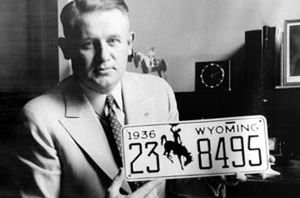 The Victoria Times piled on a few month later, commenting at how adept states such as California and Wyoming (the latter with its distinctive bucking bronco image introduced the previous year - and as shown at right) were at promoting themselves through their license plate designs.
The Victoria Times piled on a few month later, commenting at how adept states such as California and Wyoming (the latter with its distinctive bucking bronco image introduced the previous year - and as shown at right) were at promoting themselves through their license plate designs.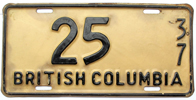
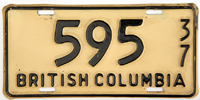
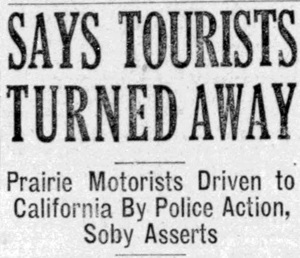 On January 30, 1937, E.W. Soby, a prominent community member of Herschel, Saskatchewan, recounted to the local Victoria press his story of having to "fight" to enter the province through the Crowsnest Pass on his way to his winter home in Cadboro Bay. According to Soby;
On January 30, 1937, E.W. Soby, a prominent community member of Herschel, Saskatchewan, recounted to the local Victoria press his story of having to "fight" to enter the province through the Crowsnest Pass on his way to his winter home in Cadboro Bay. According to Soby;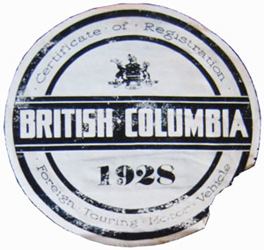 In the 1930s, tourist were also required to display a permit and notices and the form that this "permit" took changed over time (image at right bein an example from 1928) and additional information can be found on our "
In the 1930s, tourist were also required to display a permit and notices and the form that this "permit" took changed over time (image at right bein an example from 1928) and additional information can be found on our "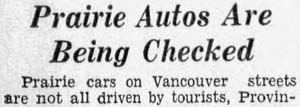 October of 1936 is also when the Provincial Police began targeting vehicles in Vancouver still displaying Alberta, Saskatchewan and Manitoba license plates in pursuit of those who had made it though the border on one of the 5,768 tourist permits issued but had now over-stayed their visit. This enforcement was stepped up after January 1, 1937, when the license plates of six (6) other province's expired on the end of the calendar year.
October of 1936 is also when the Provincial Police began targeting vehicles in Vancouver still displaying Alberta, Saskatchewan and Manitoba license plates in pursuit of those who had made it though the border on one of the 5,768 tourist permits issued but had now over-stayed their visit. This enforcement was stepped up after January 1, 1937, when the license plates of six (6) other province's expired on the end of the calendar year.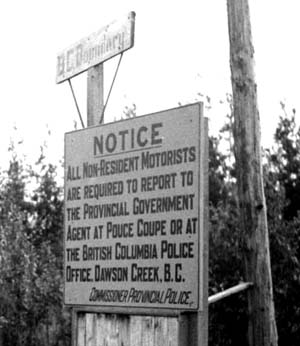 The Vancouver press, defending local honour against the attacks by the Free Press, pointed out that "there are facts to be considered on the British Columbia side. This province objects to becoming a dumping ground for prairie derelicts, just as the prairies would object to our unemployed and unemployables being thrown on them to feed and shelter. The work our police set out to do at the border was to stop the influx of relief cases masquerading as tourists."
The Vancouver press, defending local honour against the attacks by the Free Press, pointed out that "there are facts to be considered on the British Columbia side. This province objects to becoming a dumping ground for prairie derelicts, just as the prairies would object to our unemployed and unemployables being thrown on them to feed and shelter. The work our police set out to do at the border was to stop the influx of relief cases masquerading as tourists."
 The colour of the 1938 plates was announced as cream on a maroon, or "dark maroon" background.
The colour of the 1938 plates was announced as cream on a maroon, or "dark maroon" background. 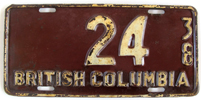

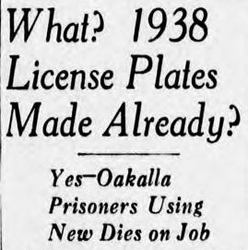 It is known that the dies used to stamp letter and numbers into license plates don't last forever and that their life-span in this era might have been between 10-15 years.
It is known that the dies used to stamp letter and numbers into license plates don't last forever and that their life-span in this era might have been between 10-15 years.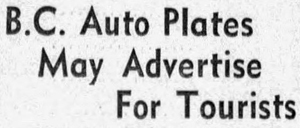 The semi-regular call for a slogan, emblem or both to be included on BC license plates re-surfaced in 1938 ahead of the "World's Fair" scheduled for the following year in San Francisco.
The semi-regular call for a slogan, emblem or both to be included on BC license plates re-surfaced in 1938 ahead of the "World's Fair" scheduled for the following year in San Francisco.
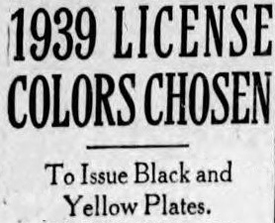 The 1939 license plate colours of "black letters and figures on a canary yellow background" were announced in July of 1938 and had been "worked out so as to not conflict with plates issued by the western provinces and states across the border."
The 1939 license plate colours of "black letters and figures on a canary yellow background" were announced in July of 1938 and had been "worked out so as to not conflict with plates issued by the western provinces and states across the border."